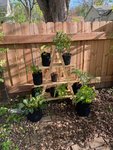

This summer, you may have brought your houseplants outside to enjoy the warmth and humidity – I certainly did! As the nights get colder and days get shorter, it’s time to bring houseplants back inside for the winter. There are several things to consider to give your plants an easy transition back to the house.
First – if you generally keep your houseplants inside the house, consider giving them a “summer vacation” outside next year! Many houseplants are native to tropical climates, so they tend to thrive in Minnesota’s hot and humid summer weather. If you’ve ever wondered why your houseplants don’t seem to grow much, try setting them outside in the spring when the weather is consistently above 50 degrees overnight. You may be surprised by their rapid growth over the summer months! If you have an indoor palm tree, I’d particularly recommend bringing it outside to enjoy the warm weather. Ferns also thrive outdoors in the humidity (but be careful to keep them out of direct sunlight to avoid sunburn).
When you bring houseplants outside in the spring, you should slowly acclimate them to the brighter light and more variable outdoor temperatures. The same is true in reverse when bringing houseplants back inside in the fall. In general, give plants plenty of time to acclimate to new conditions. If you have a three season porch or small greenhouse, this can be a great intermediate location to get plants used to being inside again. Otherwise, I’ve had success just keeping them next to a large sunny window, which I open during the day and close at night when the temperature drops. Also, natural sunlight is much more intense than the sun that comes in through a window, so once you bring your plants inside, you’ll want to keep them in a sunny location for a while and gradually reduce sun exposure.
It’s also important to make sure your houseplants aren’t bringing in any insect hitchhikers. When the plants are outside, it’s not a big deal if they have a few aphids, mealybugs, or other pests – but if those pests are brought inside your warm home as the weather cools, you could end up with a major infestation. Make sure to closely inspect your plants for pests. Some people completely repot all of their plants with fresh potting mix before bringing them back inside, but I don’t usually go to that much trouble. You can soak plants in a bucket of water with a few drops of mild dish detergent, or give them a good spray with the hose to clean the leaves and dislodge any pests. If you opt for the hose treatment, it’s a good idea to individually wipe down each leaf, as well. I like to use a systemic treatment before bringing houseplants inside to make sure there are no pests hiding in the soil.
This is also a good time to separate or repot plants if needed. If your plants have gotten too big for their pots over the summer, you can create more plants by carefully separating the root ball into two (or more) pieces and replanting each piece in its own pot. Alternatively, if you want to keep the plant large, you can put the whole thing into a new pot that’s about two inches larger. Don’t go too big when choosing a new pot – it’s much easier to overwater when using a large pot because it holds a lot of potting mix, which retains water around the roots. Also, some common houseplants prefer to be a little crowded in their pot, so don’t rush to repot them. These include peace lilies, spider plants, snake plants, ZZ plants, and aloe.
I’ll close with one top tip for keeping houseplants alive over the winter, and that’s to think tropical. Many people have told me that they’re just not good with houseplants – but honestly, it’s not too surprising that plants adapted to tropical environments have a hard time in Minnesota winters, with 30% humidity, seven hours of sunlight, and a sharp difference between cold drafts and strong heat from a radiator or vent. Adding humidifiers and grow lights to try to mimic tropical conditions, and keeping your plants away from cold windows and doors, can make a world of difference.
For more information, check out the University of Minnesota Extension Yard and Garden website. Extension resources are written by experts, and contain the latest and most reliable research-based information. Happy gardening!
Comments
No comments on this item Please log in to comment by clicking here